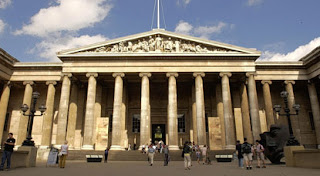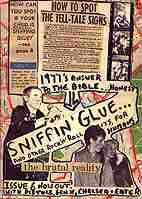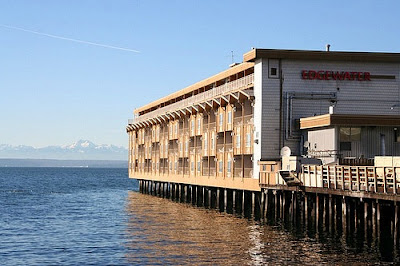In the summer of 1976, I left Essex University and moved to London. I moved into a squat in Muswell Hill with some art students from Middlesex Polytechnic. There were very few decent jobs to be had at that time. So I became a security guard. I had a uniform and a hat and everything.
This was my arty period.
We were contracted to guard the exhibition rooms in most of London's top galleries and museums.
I worked at The Hayward on the South Bank, The Tate, The National and The British Museum.
It was deathly, dull work and a crushing, mindless way of earning a living.
The worst gig was guarding the clock room at The British Museum. Hundreds of clocks wherever you looked. Wherever you went in that room, you couldn't avoid seeing the time of day.
It felt like you were watching every second of your life tick away.
Still, it was better than some of the other guard gigs we were given. All-night shifts keeping squatters out of empty mansion houses in Hampstead. I hated those jobs. I was convinced the places were haunted, they gave me the creeps.Keeping squatters out. That was a bit of a farce really, seeing as I was only managing to live in London by squatting myself. Museum gigs were better, though the work seemed fairly pointless. Telling people not to touch the sculptures. They always did it. You could see them a mile off. They couldn't resist a furtive feel up. I'd see them, looking intensely, moving closer, then the fingers flicking out. Me shouting, "Please don't touch the sculptures. Thank you".
"Or what?" No-one ever asked me that question, but I did wonder sometimes.
"What are you going to do about it if I touch it?"
"Oh, you know, give you a knuckle sandwich. Batter nine bells out of you". Get you arrested for fondling an old bit of stone. They'd look sheepish, mouth a polite, "sorry" and move on.
Then the next person would be there and the whole ritual would start again. I felt like screaming some days, "look twunt, can't you read? Don't touch the fucking exhibits, okay?"But I didn't. I kept it under control.
When I was feeling really rebellious, or sick of the parrot-like repetition, I'd turn my back, look the other way and let them get on with their illicit sculpture fiddlings. |
| Equivalent VIII |
This caused uproar in the popular press because taxpayers' money had been spent on paying an inflated price for a pile of bricks. (At 2011 prices, 120 bricks cost around £30). When the Tate first exhibited Equivalent VIII, a visitor threw blue liquid onto it. It was vegetable dye, and washed off easily. But it caused a panic amongst museum curators and exhibit safety was a major issue of the day in the mad nutty world of security guarding.
The name, "The British Museum", really is a joke as well.There is hardly anything of British origin in there at all. Its full of mummies from Egypt, statues from Syria, ancient Persian scrolls."The Museum of Artefacts Stolen by British Colonialists Whilst On The Grand Tour" would be a more accurate title.Like the Elgin Marbles. Or The Parthenon Marbles as they are known in Greece, originally being part of The Parthenon in Athens until Lord Elgin "acquired" them.Three events changed the world that summer.The first took place at the Lesser Free Trade Hall in Manchester on June 4th.It featured The Sex Pistols and unlike thousands who have claimed otherwise since, I was not there.It has been well documented who did attend that gig -The Buzzcocks promoted it and the founding members of The Smiths, Joy Division, The Fall and Factory Records were amongst the audience of 40 people, along with Mick Hucknall from Simply Red.June also saw the publication of Mark Perry's "Sniffin' Glue and Other Rock n Roll Habits For Punks" fanzine.Taking its title from a Ramones song, this punk-zine remixed the counterculture ethos of the hippy underground press for a new “do it yourself” generation."Sniffin' Glue” was hand written, photocopied and stapled together. Issue 1 sold 50 copies and featured The Ramones and "punk reviews" on the cover.It pioneered the DIY ethic and lasted for eighteen months.When it was over, Perry compiled his favourite bits into a book he titled "The Bible".A month on from these era defining moments, I was in the Duveen Gallery at The British Museum guarding the Elgin Marbles.It was the Monday after sweltering at the now almost mystical 4th of July gig in The Roundhouse, Camden Town, the night before.The Flaming Groovies supported by The Stranglers and The Ramones. It had been an epic night, cited now as the event that ignited the London punk rock scene and changed the world forever. The Clash, The Sex Pistols, The Damned and countless other future punks were amongst the crowd of 3,000 that dripped in sauna-like heat that evening."Hey Ho, Let's Go!"I can still remember the sets The Stranglers and Ramones tore through. I couldn't tell you the name of a single song The Flaming Groovies played that night. “Shake Some Action” probably, but that's just an educated assumption.So it goes sometimes, I guess.The Stranglers sneered and snarled a lot and were vaguely menacing. They ran through the songs that were soon to be released on their incredible debut album,“Rattus Norvegicus”. Jean Jacques Burnell played his dirty growling bass lines from somewhere around his knees and the whole band oozed with “fuck off” attitude.The Ramones were very very fast. They kept it short and simple, tearing through twenty songs in thirty minutes.Dr Feelgood now seemed lame by comparison to this sonic blitzkreig. Or so it seemed at the time. Listening to their first album again, as I am as I write this, the first thing that strikes me is how slow it seems now. Times have moved on, styles and fashions have changed. The world has speeded up.The Ramones didn't just alter the musical landscape that night, as all great bands are supposed to do. They also changed the world. Music would never be the same again after their visit.Not that we realised that at the time, or that the NME agreed."Dee Dee is possibly the most half-witted specimen I've ever seen hulk over the golden boards" their reporter concluded. "The appeal is purely negative, based on their not being able to play a shit or give a shit. The thinking process involved in evaluating their performance is non-existent;it's first step moronorock strung across a selection of imbecilic adolescent ditties whose sole variation lies in the shuffling of three chords into some semblance of order. They were still oodles more exciting than the majority of bands who usually throw up our collective amusement, even if the songs are indistinguishable. "Blitzkrieg Bop" became "Loudmouth" became "53rd & 3rd."Durrrgh."This was all still rattling in my head when I went to work the next day. There was quite a contrast between the hushed atmosphere amongst the dead icons of Ancient Greece and the boiling sonic cauldron of the previous evening.Imagine my surprise, then, when Joey Ramone walked into the room. The NME called him more "stick of well-salivated chewing gum than a human being".He was tall, at least six foot six, and seemed to be dressed in the same clothes he had worn on stage the night before. He stood in the middle of the Duveen Gallery, nodding his head in approval as he scanned the Marbles. I heard him say to his escort, "yeah, man, it good shit", in a thick New York accent. Then he left again. He did not try and touch the sculptures. This was the closest I ever got to meeting The Ramones.I never got the chance to speak with one of them, but at least I can say that I saw them in their prime.Two things happened recently that brought all of this back to me.The first was seeing a young woman walking down the road wearing a vintage Ramones T-shirt. When I saw her, I thought,that young lady wasn't even been born when The Ramones were strutting their stuff.They're now more famous as a word on a fashion shirt than for anything they did to pop music.I do hope that they get some royalties from that T shirt. I almost went up to the woman, I was going to ask her if she could name any of their songs. Or if she knew where their name came from.But I didn't. You just don't do that sort of thing when you're out and about these days, do you? Paul McCartney is the answer to the name question. Its the name the ex-Beatle used when he was checking into hotels in America. He couldn't register under his real name, so he used the pseudonym Paul Ramone. As for name a song, there are so many. “Beat On The Brat With A Baseball Bat” is a personal favourite off their eponymously named debut album.Or “You Should Never Have Opened That Door” off "Leave Home", the equally brilliant follow up.The second happening was a sad one.I learned that my good friend and one time partner in crime, Mark H, had died. He was a lovely man.We had some crazy times in some wild and wacky places.Too fast to live, too young to die. Only he did die.Mark worked for the Ramones during one period of his life, he worked on their European tours and knew them well. God bless you dear friend, you are sorely missed and I wrote this piece as my dedication to you.a mutual friend called Ian has just sent me a message that pretty much sums up what a "night" out with Mark H was like.They lived in Sheffield, England in 1994 and decided to go to a football game one weekend. Ian describes what happened much better than i ever could:Well at least we had a mad LA weekend - bona fide Hollywood hills rock party with topless models diving in the swimming pool tequila gold on tap snow White dwarves and the other ones out of guns and roses etc followed by burning and dehydration at brazil vs Italy world cup final in passadena rehydration in passadena with brazil fans steely dan in open top classic chevvy on freeway back to west Hollywood barneys beanerie sunset Melrose and another rock beach party all courtesy of mr Gerry gerrard topped only by rude corner at the Rutland arms (sheffield) and the occasional rose where the sun don't shine - lurk on purco!











































